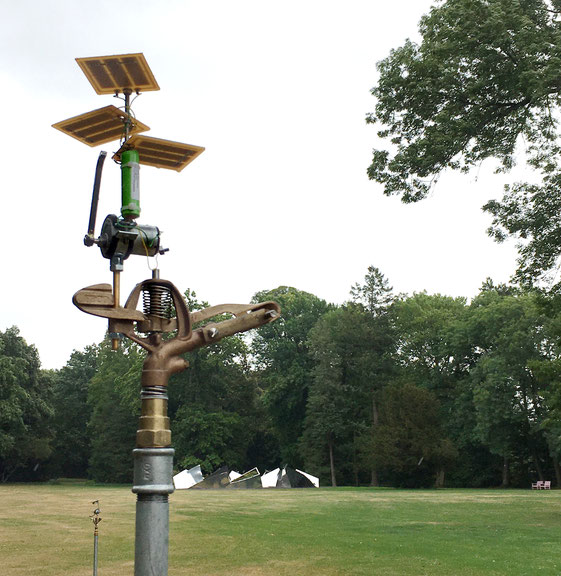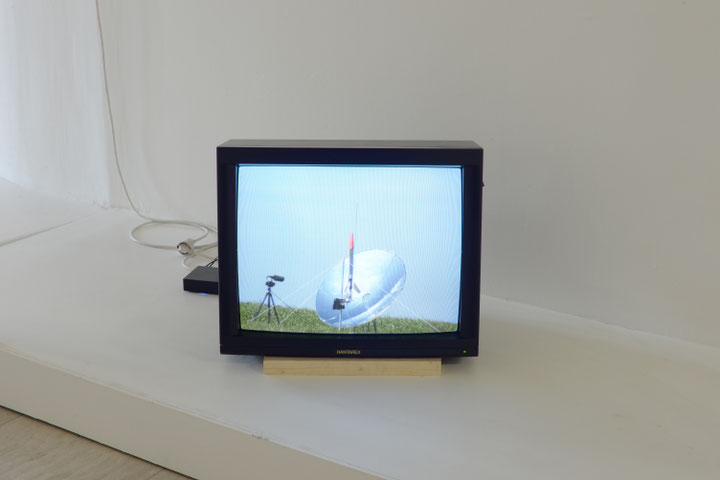Issue 1/2021 - Net section
Technical Art as a Critique of Civilization
In search of ecologically friendly renewable media
“Art and technology, a new unity”: that was the wording the Weimar Bauhaus picked in 1923 to describe its systemic pivot towards a mindset inspired by industrial methods. In 1909, the Italian Futurists’ founding manifesto had already celebrated the beauty of a racing car, its bodywork adorned with large conduits resembling snakes with explosive breath, and claiming that it outdid the Nike of Samothrace, abandoning a civic understanding of art with their misogyny and glorification of violence and war. Yet shouldn’t a technology-sceptical critique of civilization have formed part of a progressive art school’s programme, reflecting its protagonists’ motivations, especially after the traumas of the First World War?
In the mid-20th century, a new euphoria about technology became apparent in the arts in the form of participatory-interactive and kinetic/apparatus-based formats. Artists sometimes became engineers, worked with cutting-edge technologies, and cultivated an interest in scientific research. However, over and above a new kind of aesthetics, the only approaches that proved relevant had a clear sense of topical issues, ascribing a symbolic function to their technical constraints, as for instance Jean Tinguely did in his Hommage à New York, commissioned by MoMA. Tinguely devised his first auto-destructive apparatus as a parable of the hyperactive financial metropolis that allegedly never sleeps. Set in motion in the museum’s sculpture garden on 17th March, 1960, the absurd machinery disassembled itself in a half-hour spectacle; only one surviving fragment remained in the museum collection. Fetishisation of the object as proof of artistic achievement had been overcome, absorbed into a fleeting process rich in associations, along with a few photographs documenting the whole process.
In retrospect, Tinguely’s performance seems almost like a foreshock presaging the Club of Rome’s 1972 study on the limits to growth. In repeatedly updated model calculations, that study warned of system-wide global collapse: by 2100 at the latest, and even as early as 2030 if “business as usual” continued. How does contemporary art react to such apocalyptic scenarios? What does it have to say about the evident destruction of the environment, unchecked exploitation of energy resources, climate change? Is it in a position to comment with its means and, if not to influence, at least to provide insight?
Younger artists reflect on industry standards such as high levels of mobility and the associated CO2 footprint. Andreas Greiner from Berlin, who was awarded Goslar’s 2019 Young Artist Kaiserring Scholarship, has not taken a plane since 2018, has changed his diet, and has turned to environmental activism. However, this young man, born in 1979, admits to having flown as many kilometres already as his parents did during their entire lifetimes.
Greiner is interested in the forest as a counterpart to a wasteful lifestyle, for the principle of sustainability was already stipulated in the Electorate of Saxony’s forestry regulations from 1560. Greiner uses artificial intelligence to fuse photographs – from the contested forest in the Hambach open-cast lignite mining area or the endangered Polish-Belarusian Białowieża primeval forest – into phenotypical forest images: moving images on video, static printouts, concentrated small-format works or pieces with impressive dimensions. His exhibition at the Mönchehaus Museum in Goslar, scheduled to run until early 2020, pointed to the function of the forest as a physico-chemical as well as emotional reservoir. One snag: the computer and storage capacities needed to generate the images probably consumed as much electricity as the average German during an entire year.
Conceptualising technology, ecology and artistic practice in conjunction – that was the plan for Kunstverein Wolfsburg, under the direction of Justin Hoffmann, and eight participants in their exhibition Erneuerbare Medien (Renewable Media) in autumn 2020. The spectrum of works shown encompassed Joaquin Fargas’ Don Quixote-like solar robots, designed to counter a polar meltdown with artificial ice crystals or combat desertification with water condensate, metaphor-laden Berlin bulky waste by Aram Bartholl, as well as the Lohberg pedal-driven bicycle power plant that is actually in operation near Dinslaken. Martin Kaltwasser uses it to provide the energy for an open-air cinema in an abandoned coal mine that has now been transformed into a cultural park.
Use of “renewable media”, such as solar energy, is however not new. In 1913, for example, what was probably the world’s first parabolic trough solar power plant went into operation, constructed by US inventor Frank Shuman (1862-1918). It operated a pumping station around 25 kilometres south of Cairo to supply distant cotton fields with Nile water. In 2008, the Swiss artist duo Christina Hemauer and Roman Keller drew attention to this forgotten pioneering feat of technological history at the Cairo Biennial, where they rebuilt part of the steel construction as No. 1 Sun Engine, as well as setting up an information kiosk at the historic site. Since 2007, Hemauer and Keller have also been working on their solar-powered rocket, which can attain flight altitudes of up to 300 metres. Back in 2005, they even transformed Joseph Beuys’ metaphorical Capri- Batterie (Capri Battery) – a lemon with a seemingly operational light bulb attached – into a working luminaire apparatus: documentations of Come on Beuys, shine! were displayed in Wolfsburg.
Beuys, the supreme father figure of art that persistently addresses humane and ecological questions, referenced both real and symbolic sources of energy: fat, felt, honey. His Multiple Phosphor-Kreuzschlitten (Phosphorus-Cross Sled) from 1972, in which he explored the multi-layered power of this chemical element, served as an art-historical reference in the Wolfsburg exhibition. Phosphorus is important for human metabolism, is a feedstock for fertilizers, and as a self-igniting substance also has a destructive history in the form of incendiary munitions or phosphorus bombs in the Second World War.
The more peaceful theme of fruit as a source of energy, not only when physically consumed, is addressed by Ingo Schulz, who connected fallen fruit via wires to form galvanic elements in the piece he showed in the exhibition. The fruit acid they contain is an electrolyte and spontaneously converts chemical energy into electrical energy. Schulz, born in 1962 and Artistic-scientific Director of the Laboratory for Sound Art at Braunschweig University of Fine Arts since 2002, is planning new and expanded variants of his Obst-Power (Fruit Power), such as the Erste niedersächsische Fallobstorchester (First Lower Saxony Falling Fruit Orchestra).
Munich-based Emanuel Mooner re-staged what is probably Germany’s first solo show powered by photovoltaics in the landscaped garden at Wolfsburg Castle, home to the Kunstverein. Mooner, born Emanuel Günther in 1972, has long-standing experience as a musician, DJ and installation artist. Here he placed a bright orange shelter by a magnificent old copper beech. Comfortably seated on a bench, visitors could listen to the music of the spheres this Singing Garden produced by photosynthesis. Information flows taken from two branches and their foliage were transformed via a frequency converter into synthesizer sounds; in overcast conditions, it created a quiet soundscape, while in sunlight a chaotic cacophony emerged.
In addition, Ingo Schulz arranged his Trockenübung (Dry Run) in the “Pleasure Ground”: a group of the kind of circular sprinklers used in agriculture, now deprived of their primary function, performed a solar-powered polyrhythmic and polyphonic sound work. A sophisticated form of “TecArt”, which, via a minimalist intervention shot through with delicate irony, touches on fundamental questions about human existence in a natural realm that has been reshaped, or, more precisely, deformed by human beings.
http://kunstverein-wolfsburg.de/exhibition/erneuerbare-medien/
https://www.moenchehaus.de/kaiserring/andreas-greiner/
Translated by Helen Ferguson

